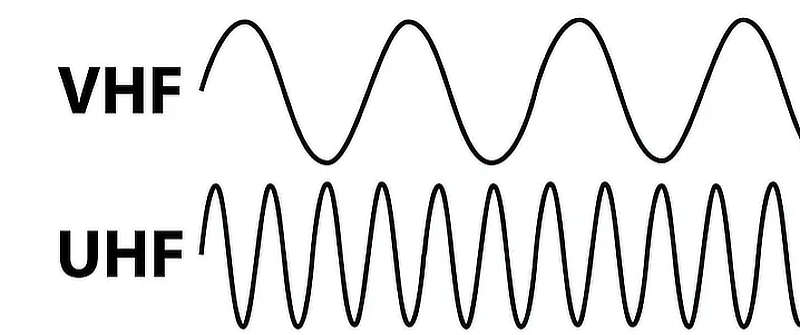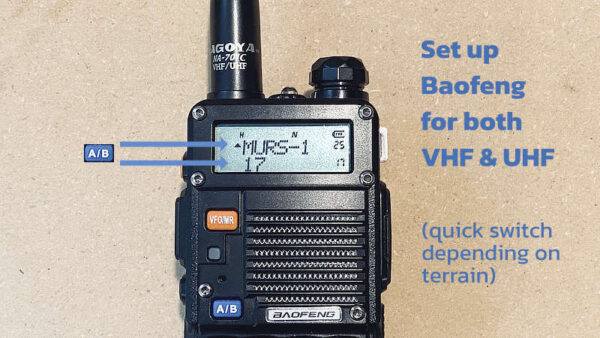VHF versus UHF for Handheld Radio Communications

Which is a better choice for radio communications performance, VHF or UHF, while using handheld 2-way radios
VHF versus UHF. Which one? That’s a great question! The first answer is, “that depends”. So lets get into some real world examples…
Note that some choices for specific frequency usage may hinge on licensing requirements. But I’m leaving that out of this discussion for your own due-diligence.
Instead, lets address a few basic technical aspects of VHF versus UHF and how they will relate to which choice is better for your application.
There are two major formats for 2-way radios. VHF and UHF. One is not better than the other. But they each have their own advantages. So it depends on how you intend to use your radios.
VHF Usage Examples for radio communications
The (free to public) MURS channels, and the Marine boating radio band are within the VHF spectrum. Other uses include licensed Commercial / Business, Fire, EMS, Police bands, Aircraft. Ham radio too (e.g. 2 meter band). VHF tv broadcast channels. Longer wavelength and likely greater distances make VHF favorable for Outdoor and Rural radio communications (compared with UHF). Hikers, Hunters, Farmers.
UHF Usage Examples for radio communications
The consumer FRS/GMRS radio bands are up in the UHF frequency range. The Ham radio 70 cm band too. UHF is also commonly used for Security comms, Construction, Warehouses, Indoors, or around Buildings. Hotels, Stores, Manufacturing, Hospitals. Favorable for radio communications within urban environments with lots of buildings (shorter wavelength for better penetration than VHF). UHF may also be better than VHF in heavily forested terrain (penetration). It’s also used for Bluetooth and WiFi signals. UHF tv broadcast channels too (better for urban reception).
VHF versus UHF Frequency Range
I’ve also included the others…
| 0.003 MHz- 0.03 MHz | Very Low Frequency (VLF) |
| .03 MHz – 0.3 MHz | Low Frequency (LF) |
| 0.3 MHz – 3 MHz | Medium Frequency (MF) |
| 3 MHz – 30 MHz | High Frequency (HF) |
| 30 MHz – 300 MHz | Very High Frequency (VHF) |
| 300 MHz – 3,000 MHz | Ultra High Frequency (UHF) |
| 3,000 MHz – 30,000 MHz | Super High Frequency (SHF) |
| 30,000 MHz – 300,000 MHz | Extra High Frequency (EHF) |
Usability depends on the environment / surroundings / geography of where you intend to operate the radios.
VHF works better in some environments while UHF works better in others. Lets look at this…
- Most typical VHF radios operate in the 138-174 MHz frequency band.
- Generally, UHF radios operate in the 400-512 MHz frequency band.
Within the communication bands that we’re talking about, UHF is roughly three times higher in frequency than VHF. Wavelength is the distance between peaks on a wave, and wavelength is inversely proportional to the frequency. So, VHF wavelength is about three times longer than UHF.
VHF wavelengths are longer that UHF. Lets compare the two, using some common radio communication bands. MURS & Marine (VHF) versus FRS/GMRS (UHF).
| MURS Ch. 1 (151.820 MHz) | Wavelength (6.48 Feet) |
| Marine Ch. 68 (156.425 MHz) | Wavelength (6.29 Feet) |
| FRS/GMRS Ch. 8 (467.5625 MHz) | Wavelength (2.1 Feet) |
| FRS/GMRS Ch. 17 (462.6000 MHz) | Wavelength (2.13 Feet) |
The shorter wavelengths such as those used in FRS/GMRS (UHF) will more readily traverse through windows, doors, and other relatively small openings and pathways, as well as penetrate right through walls, even concrete. The penalty is distance, although this might not matter for most typical uses within this band.
On the other hand, VHF wavelengths (e.g. MURS or the Marine radio band) have the potential to communicate longer distances than UHF. VHF waves can still make it through buildings and such, to an extent – but just not as well as UHF (and at a distance penalty in that environment). However VHF is excellent for the relatively open outdoors environments, including the rural countryside and some forested terrain (though attenuation does occur with forest density).
Keep in mind that both VHF and UHF communications are “line of sight”. While UHF is better to penetrate buildings and things, if there’s a hill or mountain in the middle… VHF/UHF Nope… No can do.
Which is better for communications in the woods, VHF or UHF
In my opinion, this is a tricky question. Anything that gets in the way, regardless of VHF or UHF, will attenuate the signal to some extent. That includes trees and vegetation.
In reality, the ‘woods’ or forest vary, sometimes a lot. In my region here in northern New Hampshire, the forest woods can get ridiculously thick at times. Whereas while living in a previous location years ago, my experiences visiting the Sierra Nevada mountain regions – those ‘woods’ were much less dense than here. You could see into the forest a good distance in comparison. Choices… VHF (distance) versus UHF (penetration) as to how it relates to the forest density you’re dealing with.
VHF signals may be reflected and refracted slightly around and over hillsides. They tend to “hug” the earth better, providing better performance outdoors or in hilly terrain.
If traversing through wooded terrain with another party or partner (e.g. hiking or hunting), chances are that you won’t be too far apart. So UHF comms might make sense. But on the other hand, VHF may better favor your terrain, depending…
Is that clearer than mud now?
Baofeng Radio for both VHF and UHF bands
Here’s a thought. If you have a Baofeng radio (very common among the prepper-preparedness community), try this… Set your ‘A’ channel to a MURS channel (any of the five). Then set your ‘B’ channel to one of the FRS/GMRS channels. Now you’ve got both VHF and UHF ready to go. Experiment. Discover what might work better for your environment.
Here’s an example of my radio set for MURS-1 and GMRS-17. If I’m out on the property woods or wherever (or for experimentation), I can communicate back to the mother ship and have Mrs. J switch from A to B or vice versa – while I do the same. Quick and easy.

What a great little 2-way radio (HT, handheld transceiver). It’s not in the same league as Icom or Yaesu or Kenwood… but they’ve worked quite well for my purposes versus price. I’ve got half a dozen. A pair for home use, another pair for the truck, and another in an EMP bag. I might add another pair to that bag too, just in case…
Baofeng BF-F8HP
(amzn)
Important! If you operate the Baofeng on VHF or UHF, be sure to read my article about the using the right Baofeng antenna for these bands. It makes a BIG difference! Upgrade that stock antenna…
[ Read: Best BaoFeng Antenna Upgrade for Ham Radio or GMRS, FRS, MURS Bands ]
[ Read: Baofeng Extended Battery For Longer Life Between Charges ]
and one more…
[ Read: Chirp Software for Programming a Baofeng Radio – How to use ]
